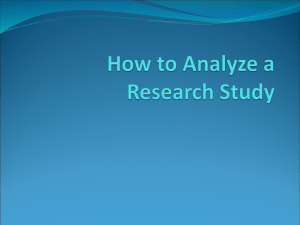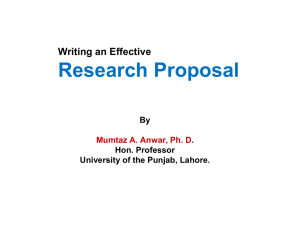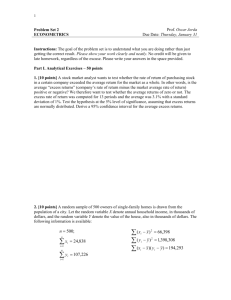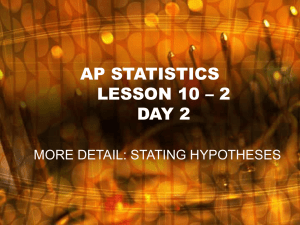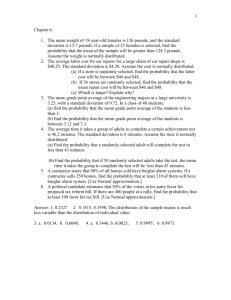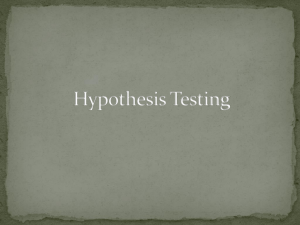Ch. 11 Review IB Statistics
advertisement
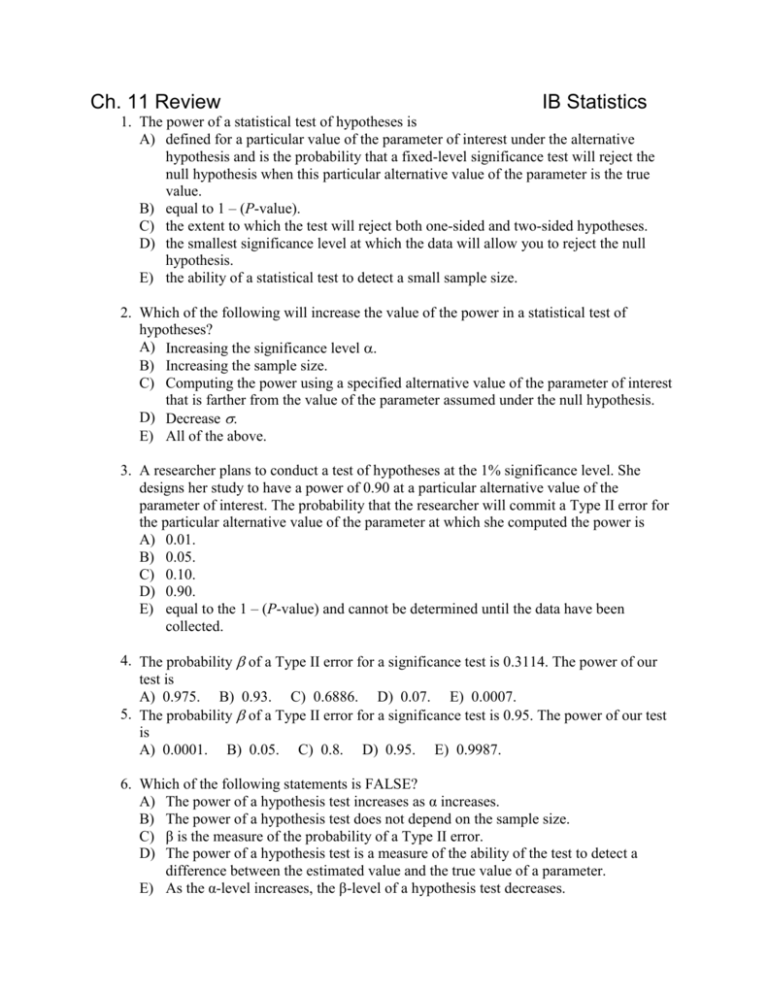
Ch. 11 Review IB Statistics 1. The power of a statistical test of hypotheses is A) defined for a particular value of the parameter of interest under the alternative hypothesis and is the probability that a fixed-level significance test will reject the null hypothesis when this particular alternative value of the parameter is the true value. B) equal to 1 – (P-value). C) the extent to which the test will reject both one-sided and two-sided hypotheses. D) the smallest significance level at which the data will allow you to reject the null hypothesis. E) the ability of a statistical test to detect a small sample size. 2. Which of the following will increase the value of the power in a statistical test of hypotheses? A) Increasing the significance level . B) Increasing the sample size. C) Computing the power using a specified alternative value of the parameter of interest that is farther from the value of the parameter assumed under the null hypothesis. D) Decrease E) All of the above. 3. A researcher plans to conduct a test of hypotheses at the 1% significance level. She designs her study to have a power of 0.90 at a particular alternative value of the parameter of interest. The probability that the researcher will commit a Type II error for the particular alternative value of the parameter at which she computed the power is A) 0.01. B) 0.05. C) 0.10. D) 0.90. E) equal to the 1 – (P-value) and cannot be determined until the data have been collected. 4. The probability of a Type II error for a significance test is 0.3114. The power of our test is A) 0.975. B) 0.93. C) 0.6886. D) 0.07. E) 0.0007. 5. The probability of a Type II error for a significance test is 0.95. The power of our test is A) 0.0001. B) 0.05. C) 0.8. D) 0.95. E) 0.9987. 6. Which of the following statements is FALSE? A) The power of a hypothesis test increases as α increases. B) The power of a hypothesis test does not depend on the sample size. C) β is the measure of the probability of a Type II error. D) The power of a hypothesis test is a measure of the ability of the test to detect a difference between the estimated value and the true value of a parameter. E) As the α-level increases, the β-level of a hypothesis test decreases. 7. Cooks at a student cafeteria claim that the mean amount of sodium in each meal is 375 mg. The district nutritionist says that amount is not correct. Which of the following is the correct pair of hypotheses to test? A) H0: 375 vs. Ha: > 375. B) H0: 375 vs. Ha: > 375. C) H0: 375 vs. Ha: 375. D) H0: 375 vs. Ha: > 375. E) H0: = 375 vs. Ha: 375. 8. A car manufacturer claims that an experimental new battery will last 6 years (standard car batteries last about 4 years). A consumer affairs representative believes the new experimental battery will last less than 6 years. Which of the following is the correct pair of hypotheses to test? A) H0: = 6 vs. Ha: > 6. B) H0: = 6 vs. Ha: 6. C) H0: < 6 vs. Ha: 6. D) H0: 6 vs. Ha: < 6. E) H0: = 6 vs. Ha: < 6. 9. A researcher checks the body temperature of 30 randomly selected adult males and finds that the sample mean X = 98.4o F. If is known to be 0.62° F., which of the following is the correct result for the claim H 0 : 98.6 vs. H a : 98.6 ? (Hint: use Z-Test) A) P 0.001. B) 0.001 P 0.01. C) 0.01 P 0.05 . D) 0.05 P 0.10 . E) P 0.10 . 10. An advertiser wishes to see if a new advertisement is effective in promoting an existing product. The previous advertisement has a recognition score of 3.7. An SRS of 23 potential buyers resulted in a recognition score of 3.4 for the sample. The standard deviation of the population is known to be 1.7. Which of the following required conditions for conducting a z-test has not been met? A) The population is at least 10 times the sample size. B) The data are taken from a simple random sample. C) The data appear to be approximately normal. D) The decision of each buyer is independent. E) All of the required conditions are met. 11. A traffic control engineer conducts a hypothesis test regarding the number of accidents on a slippery road in winter conditions. In the past there has been an average of 10 accidents a week on the road. Salt water is sprayed on the road before predicted snowstorms. The number of accidents on the road after the treatment drops to 7 accidents per week. Let b = number of accidents before treatment and a = number of accidents after treatment. The P-value of the hypothesis test H0: b = a vs. Ha: a < b was found to be 0.03. Which of the following statements is true? A) The number of accidents dropped by 3%. B) Three percent of the time, there should be fewer accidents on the treated road. C) The mean number of accidents should be within 3% of each other. D) The probability of randomly achieving a difference in the means of at least 3 if the means were equal is 3%. E) The probability of randomly achieving a reduction in the means of at least 3 if the means were equal is 3%. 12. In formulating hypotheses for a statistical test of significance, the null hypothesis is often A) a statement that there is “no effect” or “no difference.” B) proven correct. C) a statement that the data are all 0. D) 0.05. E) the probability of observing the data you actually obtained. 13. In tests of significance about an unknown parameter of some population, which of the following is considered strong evidence against the null hypothesis? A) The value of an estimate of the unknown parameter based on a simple random sample from the population is not equal to zero. B) We observe a value of an estimate of the unknown parameter based on a simple random sample from the population that is very consistent with the null hypothesis. C) High P-value. D) Low P-value. E) The value of an estimate of the unknown parameter based on a simple random sample from the population is equal to zero. 14. In the last mayoral election in a large city, 47% of the adults over the age of 65 voted Republican. A researcher wishes to determine if the proportion of adults over the age of 65 in the city who plan to vote Republican in the next mayoral election has changed. Let p represent the proportion of the population of all adults over the age of 65 in the city who plan to vote Republican in the next mayoral election. In terms of p, the researcher should test which of the following null and alternative hypotheses? A) H0: p = 0.47, Ha: p > 0.47. B) H0: p = 0.47, Ha: p 0.47. C) H0: p ≤ 0.47, Ha: p > 0.47. D) H0: p = 0.47, Ha: p = 0.47 0.03, since 0.03 is the margin of error for most polls. E) H0: p = 0.47, Ha: p < 0.47. 15. The mean area of the several thousand apartments in a new development is advertised to be 1250 square feet. A tenant group thinks that the apartments are smaller than advertised. They hire an engineer to measure a sample of apartments to test their suspicion. The null and alternative hypotheses, H0 and Ha, for an appropriate test of hypotheses are A) H0: = 1250, Ha: 1250. B) H0: = 1250, Ha: < 1250. C) H0: ≤ 1250, Ha: > 1250. D) H0: = 1250, Ha: > 1250. E) incapable of being specified without knowing the size of the sample used by the engineer. 16. We want to know if the mean height of all adult American males between the ages of 18 and 21 is now over 6 feet. If the population of all adult American males between the ages of 18 and 21 has mean height of feet and standard deviation feet, which of the following null and alternative hypotheses would we use to conduct a test of hypotheses to answer this question? A) H0: ≥ 6, Ha: < 6. B) H0: = 6, Ha: < 6. C) H0: = 6, Ha: 6. D) H0: = 6, Ha: = 6 X , assuming our sample size is n. E) H0: = 6, Ha: > 6. 17. In a test of significance, the probability, assuming the null hypothesis is true, that the test statistic will take a value at least as extreme as the value actually observed is A) the P-value of the test. B) the level of significance of the test. C) the critical z-score of the test. D) the probability the null hypothesis is false. E) the probability the null hypothesis is true. 18. In testing hypotheses, which of the following would be strong evidence against the null hypothesis? A) Using a small level of significance. D) Obtaining data with a large P-value. B) Using a large level of significance. E) Obtaining data with a small sample standard deviation. C) Obtaining data with a small P-value. 19. In a statistical test of hypotheses, we say the data are statistically significant at level if A) = 0.01. D) the P-value is larger than . B) = 0.05. E) is small. C) the P-value is at most . 20. In a test of statistical hypotheses, the P-value tells us A) if the null hypothesis is true. B) if the alternative hypothesis is true. C) the smallest level of significance at which the null hypothesis can be accepted. D) the smallest level of significance at which the null hypothesis can be rejected. E) the largest level of significance at which the null hypothesis can be rejected. 21. We test the null hypothesis H0: = 10 against the alternative Ha: < 10 for a normal population with = 4. A random sample of 16 observations is drawn from the population, and we find the sample mean of these observations to be X = 12. The Pvalue is closest to A) 0.0228. B) 0.0456. C) 0.10. D) 0.9544. E) 0.9772. 22. The Survey of Study Habits and Attitudes (SSHA) is a psychological test that measures the motivation, attitude, and study habits of college students. Scores range from 0 to 200 and follow (approximately) a normal distribution with mean 117 and standard deviation = 32. You suspect that incoming freshmen have a mean that is different from 117, since they are often excited yet anxious about entering college. To test your suspicion, you test the hypotheses H0: = 117, Ha: 117. You select an SRS of 100 incoming freshmen, give them SSHA, and find that their mean score is 122. The P-value of your test is closest to A) 0.1182. B) 0.2302. C) 0.4052. D) 0.5948. E) 0.9993. 23. The level of calcium in the blood of healthy young adults follows a normal distribution with mean = 10 milligrams per deciliter (mg/dl) and standard deviation = 0.4 mg/dl. A clinic measures the blood calcium of 100 healthy pregnant young women at their first visit for prenatal care. The mean of these 100 measurements is X = 9.8 mg/dl. Is this evidence that the mean calcium level in the population from which these women come is less than the general population’s mean level of 10 mg/dl? To answer this question, we test the hypotheses H0: = 10, Ha: < 10. The P-value of the test is A) less than 0.0002. B) 0.0002. C) 0.3085. D) 0.6170. E) greater than 0.99. 24. The nicotine content in milligrams (mg) in cigarettes of a certain brand is normally distributed with mean and standard deviation = 0.1 mg. The brand advertises that the mean nicotine content of its cigarettes is 1.5 mg, but measurements on a random sample of 100 cigarettes of this brand gave a mean of X = 1.53 mg. Is this evidence that the mean nicotine content is actually higher than advertised? To answer this question, we test the hypotheses H0: = 1.5, Ha: > 1.5 at the 5% significance level. Based on the results, we conclude that A) H0 should be rejected. B) H0 should not be rejected. C) H0 should be accepted. D) there is a 5% chance that the null hypothesis is true. E) Ha should be rejected. 25. The time needed for college students to complete a certain paper-and-pencil maze follows a normal distribution with a mean of 50 seconds and a standard deviation of 6 seconds. You wish to see if the mean completion time is changed by vigorous exercise, so you have an SRS of 20 college students exercise vigorously for 30 minutes and then complete the maze. It takes them an average of X = 52 seconds to complete the maze. You use this information to test the hypotheses H0: = 50, Ha: 50 at the 10% significance level. Based on the results, you conclude that A) H0 should not be rejected. B) H0 should be rejected. C) Ha should be accepted. D) this is a borderline case and no decision should be made. E) H0 should be accepted. 26. The time needed for college students to complete a certain paper-and-pencil maze follows a normal distribution with a mean of 30 seconds and a standard deviation of 3 seconds. You wish to see if the mean time is changed by vigorous exercise, so you have a group of nine college students exercise vigorously for 30 minutes and then complete the maze. You compute the average time X that it takes these students to complete the maze and test the hypotheses H0: = 30, Ha: 30. You find that the test results are significant at the 5% level. You may also conclude that A) the test would also be significant at the 10% level. B) the test would also be significant at the 1% level. C) the level of significance cannot be determined since the sample mean X is not given. D) both A) and B) are true. E) none of the above is true. 27. An agricultural researcher plants 25 plots with a new variety of corn. The average yield for these plots is X = 150 bushels per acre. Assume that the yield per acre for the new variety of corn follows a normal distribution with unknown mean and that a 95% confidence interval for is found to be 150 3.29. Which of the following is true? A) A test of the hypotheses H0: = 150, Ha: 150 will be significant at the 0.05 level. B) A test of the hypotheses H0: = 150, Ha: > 150 will be significant at the 0.05 level. C) A test of the hypotheses H0: = 160, Ha: 160 will be significant at the 0.05 level. D) 5% of all sample means will be significant at the 0.05 level. E) No hypothesis test can be conducted because we do not know . 28. A certain population follows a normal distribution with mean and standard deviation = 2.5. You collect data and test the hypotheses H0: = 1, Ha: 1. You obtain a Pvalue of 0.022. Which of the following is true? A) A 95% confidence interval for will include the value 1. B) A 95% confidence interval for will include the value 0. C) A 99% confidence interval for will include the value 1. D) A 99% confidence interval for will include the value 0. E) 2.2% of the time, the 99% confidence intervalfor will not contain the true value of Use the following to answer questions 29 and 30: A researcher wishes to determine if students are able to complete a certain pencil-and-paper maze more quickly while listening to classical music. Suppose the time (in seconds) needed for high school students to complete the maze while listening to classical music follows a normal distribution with mean and standard deviation = 4 seconds. Suppose that in the general population of all high school students, the time needed to complete the maze without listening to classical music also follows a normal distribution with mean 40 seconds and standard deviation = 4 seconds. The researcher, therefore, decides to test the hypotheses H0: = 40, Ha: < 40. To do so, the researcher has 10,000 high school students complete the maze with classical music playing. The mean completion time for these students is X = 39.8 seconds, and the P-value is less than 0.0001. 29. From the test results, it is appropriate to conclude which of the following? A) The researcher has strong evidence that high school students listening to classical music can complete the maze in exactly 39.8 seconds. B) The researcher has strong evidence that listening to classical music substantially increases the time it takes high school students to complete the maze. C) The researcher has moderate evidence that listening to classical music substantially reduces the time it takes high school students to complete the maze. D) The researcher has proved that for high school students, listening to classical music substantially reduces the time it takes to complete the maze. E) None of the above. 30. Suppose that two high school students decide to see if they get the same results as the researcher. They both take the maze while listening to classical music. The mean of their times is X = 39.8 seconds, the same as that of the researcher. It is appropriate to conclude which of the following? A) The students have reproduced the results of the researcher, and their P-value will be the same as that of the researcher. B) The students have reproduced the results of the researcher, but their P-value will be slightly smaller than that of the researcher. C) The students have reproduced the results of the researcher, but their P-value will be substantially smaller than that of the researcher. D) The students will reach the same statistical conclusion as the researcher, but their Pvalue will be a bit different from that of the researcher. E) None of the above. 31. A medical researcher is working on a new treatment for a certain type of cancer. The average survival time after diagnosis for patients on the standard treatment is two years. In an early trial, she tries the new treatment on three subjects who have an average survival time after diagnosis of four years. Although the survival time has doubled, the results are not statistically significant, even at the 0.10 significance level. The best explanation for this result is that A) the placebo effect is present, which limits statistical significance. B) the sample size is too small to determine if the observed increase cannot be reasonably attributed to chance. C) although the survival time has doubled, in reality the actual increase is still two years. D) subjects who survive two years are more likely to survive four years. E) the calculation was in error. The researchers forgot to include the sample size. 32. An engineer designs an improved light bulb. The previous design had an average lifetime of 1200 hours. The mean lifetime of a random sample of 2000 of the new bulbs is found to be 1201 hours. Although the difference is quite small, the effect was found to be statistically significant. The best explanation for this result is that A) new designs typically have more variability than standard designs. B) the sample size is very large. C) the mean of 1200 is large. D) the power of the statistical test is small. E) all of the above are true. 33. A small company consists of 25 employees. As a service to the employees, the company arranges for each employee to have a complete physical for free. Among other variables, the weight of each employee is measured. The mean weight of the 25 employees is found to be 165 pounds, and the population standard deviation is 20 pounds. It is believed that a mean weight of 160 pounds would be normal for this group. To see if there is evidence that the mean weight of the population of all employees of the company is significantly higher than 160 pounds, the hypotheses H0: = 160 vs. Ha: > 160 are tested. You obtain a P-value of less than 0.1056. Which of the following is true? A) At the 5% significance level, you have proved that H0 is true. B) You have failed to obtain any evidence for Ha. C) At the 5% significance level, you have failed to prove that H0 is true, and a larger sample size is needed to do so. D) Only 10.56% of the employees weigh less than 160 pounds. E) With such a high P-value, you have very little evidence against H0. 34. Ten years ago, the mean Math SAT (SAT-M) score of all high school students who took the exam at a small high school was 490 with a standard deviation of 80. A boxplot of the SAT-M scores of a random sample of 25 students at the same high school who took the exam this year is given below. The mean score of these 25 students is X = 530. We assume the population standard deviation continues to be = 80. To determine if there is evidence that the average SAT-M score in the district has improved, the hypotheses H0: = 490 vs. Ha: > 490 are tested using the z statistic, and the P-value is found to be 0.0062. We may conclude that A) at the 5% significance level, we have proved that H0 is false. B) at the 5% significance level, we have proved that Ha is false. C) at the 5% significance level, we have proved that H0 is true. D) it would have been more appropriate for us to use a two-sided alternative. E) none of the above is true. 35. Does taking ginkgo tablets twice a day provide significant improvement in mental performance? To investigate this issue, a researcher conducted a study with 150 adult subjects who took ginkgo tablets twice a day for a period of six months. At the end of the study, 200 variables related to the mental performance of the subjects were measured on each subject, and the means were compared to known means for these variables in the population of all adults. Nine of these 200 variables were significantly better (in the sense of statistical significance) at the 5% level for the group taking the ginkgo tablets as compared to the population as a whole, and one variable was significantly better at the 1% level for the group taking the ginkgo tablets as compared to the population as a whole. It would be correct to conclude that A) there is good statistical evidence that a person’s score will increase about 5% if he/she takes ginkgo tablets twice a day. B) there is good statistical evidence that taking ginkgo tablets twice a day provides improvement for the variable that was significant at the 1% level. We should be somewhat cautious about making claims for the variables that were significant at the 5% level. C) these results would have provided good statistical evidence that taking ginkgo tablets twice a day provides some improvement in mental performance if the number of subjects had been larger. It is premature to draw statistical conclusions from studies in which the number of subjects is less than the number of variables measured. D) there is good statistical evidence that taking ginkgo tablets twice a day provides some improvement in mental performance. E) none of the above is true. 36. An engineer designs an improved light bulb. The previous design had an average lifetime of 1200 hours. A random sample of 2000 new bulbs is found to have a mean lifetime of 1201 hours. Although the difference from the old mean lifetime of 1200 hours is quite small, the P-value is 0.03 and the effect is statistically significant at the 0.05 level. If, in fact, there is no difference between mean lifetimes for the new and old designs, the researcher has A) committed a Type I error. B) committed a Type II error. C) established the power of the test. D) a probability of being correct that is equal to the P-value. E) a probability of being correct that is equal to 1 – (P-value). 37. A medical researcher is working on a new treatment for a certain type of cancer. The average survival time after diagnosis for patients on the standard treatment is two years. In an early trial, she tries the new treatment on three subjects who have an average survival time after diagnosis of four years. Although the survival time has doubled, the results are not statistically significant, even at the 0.10 significance level. Suppose, in fact, that the new treatment does increase the mean survival time in the population of all patients with this particular type of cancer. The researcher has A) committed a Type I error. B) committed a Type II error. C) used a two-sided test when she should have used a one-sided test. D) incorrectly used a level 0.10 test when she should have computed the P-value. E) incorrectly used a level 0.10 test when she should have used a level 0.05 test. 38. A researcher plans to conduct a test of hypotheses at the 1% significance level. The probability that the researcher will commit a Type I error is A) 0.01. B) 0.05. C) 0.10. D) 0.99. E) equal to the P-value and cannot be determined until the data have been collected. Ch. 11 Review Answers 1. 2. 3. 4. 5. 6. 7. 8. 9. 10. 11. 12. 13. 14. 15. 16. 17. 18. 19. 20. 21. 22. 23. 24. 25. 26. 27. 28. 29. 30. 31. 32. 33. 34. 35. 36. 37. 38. A E C C B B E E D E E A D B B E A C C D E A A A A A A C E E B B E E E A B A


